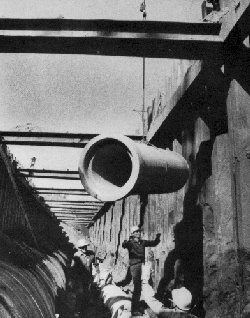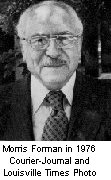Early in 1965, the Ohio River Valley Water Sanitation Commission (ORSANCO) cited MSD for its efforts to help clean up the Ohio River — efforts that had helped make the river’s waters the cleanest it had been "in modern times." The Fort Southworth treatment plant was removing about 65 percent of the solids from the water discharged into the river — far more than the 45 percent required under the weak state regulations of the time.

Courier-Journal Photo by Scott Applewhite
But concern for the environment, which led to the creation of ORSANCO shortly after World War II, was intensifying. Congress was putting the finishing touches on its first Water Quality Act, which would go into effect later that year; the act would require states to set water quality standards subject to the approval of the Department of the Interior. This would be supplemented by the Clean Water Restoration Act of 1966, which would provide federal matching funds for constructing sewage treatment plants.
Louisville and Jefferson County both were busy with improvements and developments in 1965. Construction started on the Riverside Expressway, from Third Street to Zorn Avenue; the debate continued over whether the expressway to Lexington would be allowed to go through Cherokee Park. Downtown Urban Renewal was reaching full stride, with the demolition of many old buildings. Bluegrass Industrial Park opened on 627 acres of farmland recently annexed to Jeffersontown. The number of suburban cities in Jefferson County grew to 58; the number of small sewage treatment plants outside MSD’s service area grew to about 175.
These developments were having mixed impacts on MSD.
Urban Renewal and highway construction were demolishing buildings, reducing the number of MSD customers — and MSD’s income. Urban Renewal would soon demand expensive sewer improvements, including a requirement to separate the sanitary and stormwater lines. The Water Quality Act would soon establish standards for much cleaner discharges into the Ohio River. Suburban development was booming, and MSD didn’t have the resources to keep up. When MSD eventually found the resources to expand, the proliferating small treatment plants would have to be acquired and closed.
As these challenges mounted, MSD found new leadership. In mid-1965, John Person resigned as MSD’s top executive to become head of the National Rivers and Harbors Congress in Washington, D.C. To replace him, the MSD Board chose a familiar and trusted expert: Morris Forman, who had been the district’s chief engineer almost from the beginning.
The board also created a new position for Forman — administrative consultant — and created two more top engineering positions to assist him.
Morris Forman: The Man Who Became ‘Mister MSD’

If anyone ever deserved the title of "Mister MSD," it was Morris Forman. A civil engineer, he went to work for the old Commissioners of Sewerage in 1922. He became the agency’s top administrator in 1965, and had overseen the construction of more than 600 miles of sewers and the first major treatment plant by the time he retired in 1972. He continued to serve as a special consultant until shortly before his death in 1992.
Forman’s only extended period away from Louisville’s sewers began in 1942, when the old commissioners ran out of money and disbanded. He worked as an engineer at Fort Knox until he was called back in 1945 to help the group that was organizing what would become the Metropolitan Sewer District.
Over the years, his titles varied. He was officially named chief engineer in 1948, although he had been serving as the top engineer before that. Originally, he reported directly to the MSD Board. Then, when John J. Person was hired as the agency’s first top administrator, Forman reported directly to him.
When Person resigned in 1965, the Board created a new title for the top position — "administrative consultant" — and named Forman to fill it.
In later years, employees remembered Forman’s good humor and genuine interest in them and their families.
Forman was proud of the progress MSD made over the years. "When we took over," he said, "they still had 4,000 or 5,000 privies in this town" — and all the raw sewage was flowing into the Ohio River.
Throughout his years with MSD, Forman’s position was as a consultant, not an employee. The Board continued to retain him as a consultant after his retirement — at reduced pay, in lieu of a pension. For many years afterward, he attended board meetings regularly, and served as a valuable resource for MSD’s newer employees.
Shortly before he retired, MSD honored him by re-naming its major treatment plant the Morris Forman Wastewater Treatment Plant. "It’s hard to tell you how much I appreciated it," he told Courier-Journal reporter Bill Holsted. "It makes me feel like I’ve done something."
MSD History continued - The Fort Southworth Plant


